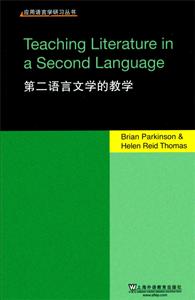-
>
心灵元气社
-
>
县中的孩子 中国县域教育生态
-
>
(精)人类的明天(八品)
-
>
厌女(增订本)
-
>
这样学习才高效/杨慧琴
-
>
心理学经典文丛:女性心理学
-
>
中国文化5000年
第二语言文学的教学 版权信息
- ISBN:9787544643221
- 条形码:9787544643221 ; 978-7-5446-4322-1
- 装帧:一般胶版纸
- 册数:暂无
- 重量:暂无
- 所属分类:>
第二语言文学的教学 内容简介
“应用语言学研习丛书”是外教社引进出版的一套全新的应用语言学学术丛书。本书为其中之一。本书介绍了翻译中的各种语言形式、体裁, 也介绍了西方翻译理论的发展。
第二语言文学的教学 目录
Acknowledgements
1 Introduction
2 What can teachers and learners do with literature?
3 The language of literature and ways of'teaching' it
4 The teaching of poetry
5 Teaching short stories
6 Teaching the novel
7 Teaching drama
8 Assessment and evaluation in literature lessons and courses
9 Research and development
Appendix 1: Study questions and exercises
Appendix 2: Some possible answers to selected study questions
References
Index
第二语言文学的教学 节选
《应用语言学研习丛书:第二语言文学的教学(英文版)》: In addition, some of the Malaysian teachers are highly critical of Western culture and Western values, which they feel may be mediated through a study ofits literature.They rarely express this criticism openly but for a few it may play a significant part in producing a negative attitude to what they are doing, and it is important that those who teach them are aware of this and are willing to make use of opportunities to bring such cultural questions to the surface in a supportive and non-confrontational way rather than prerending that they do nor exist. The attempted solution to these problems of dealing with literature has been that in the first year of the course the Malaysian teachers take the regular first-year General English course alongside British undergraduates, during which they read a fairly conventional and canonical set of texts including short stories, novels, plays and a selection of poems. They attend literature tutorials, which are sometimes in the form ofworkshops and sometimes general discussions, and they write conventional literary essays. In their first year they also attend a course generally taken by second-or thifd-year undergraduates called 'Ways of Reading'. This is explicidy analytical in approach, being based largely on linguistics and related theory, but it is also considerably influenced by language teaching methodology and is culturally eclectic in its choice of texts for study. All students on this course take part in a weekly work-shop exercise involving small groups, which is carefully structured and is managed by the students themselves, with a lecturer present to facilitate the feedback at the end of the session. The assignments are all practical rather than discursive in form, and the influence of language reaching methodology is apparent in this, since, rather than asking for traditional discussion, they require students 'to do things with texts',for example using cut-up texts to create new ones or changing texts around, using a variery of media. In their second (and finaD year, the Malaysian teachers take two courses designed specifically for their needs, which have a pedagogic focus: the first is concerned with the use ofliterature in a (primarily) language-centred classroom situation, referring to and developing the ideas they have already met in their first year, while the second deals with the development of a curriculum for teaching literature. By the time they are a few weeks into the second year, the majority are making connections for themselves with their first-year work and recognising and drawing with increasing confidence on the expertise that they have developed. The key words are indeed 'confidence' and 'expertise': by the end of their course most of them would agree that it is possible to learn (and therefore also teach) ways ofreading literature which are relevant to their cultural and educational situations. There has as yet been no overall evaluation by the Malaysian Government of this teacher education project (which is very large and involves a number of British universities), so it is not possible to do more than comment anecdotally on the results of which we have heard, mosdy in the form ofletters from ‘our' teachers. Those who write - a self-selected group, obviously, but there always arc a few from each cohort- do seem to be using literature in the context of language teaching, almost all for the first time: some are developing their own worksheets and materials, others who are perhaps less confident are drawing directly on materials developed during their ……
- >
经典常谈
经典常谈
¥28.3¥39.8 - >
中国人在乌苏里边疆区:历史与人类学概述
中国人在乌苏里边疆区:历史与人类学概述
¥36.0¥48.0 - >
伊索寓言-世界文学名著典藏-全译本
伊索寓言-世界文学名著典藏-全译本
¥9.3¥19.0 - >
名家带你读鲁迅:朝花夕拾
名家带你读鲁迅:朝花夕拾
¥10.5¥21.0 - >
小考拉的故事-套装共3册
小考拉的故事-套装共3册
¥36.7¥68.0 - >
莉莉和章鱼
莉莉和章鱼
¥14.3¥42.0 - >
诗经-先民的歌唱
诗经-先民的歌唱
¥13.5¥39.8 - >
巴金-再思录
巴金-再思录
¥14.7¥46.0
-
字海探源
¥25¥78 -
《标点符号用法》解读
¥8.3¥15 -
文言津逮
¥10.2¥28 -
那时的大学
¥12¥28 -
现代汉语通用字笔顺规范
¥19.6¥58 -
2020年《咬文嚼字》合订本
¥23.8¥60




















